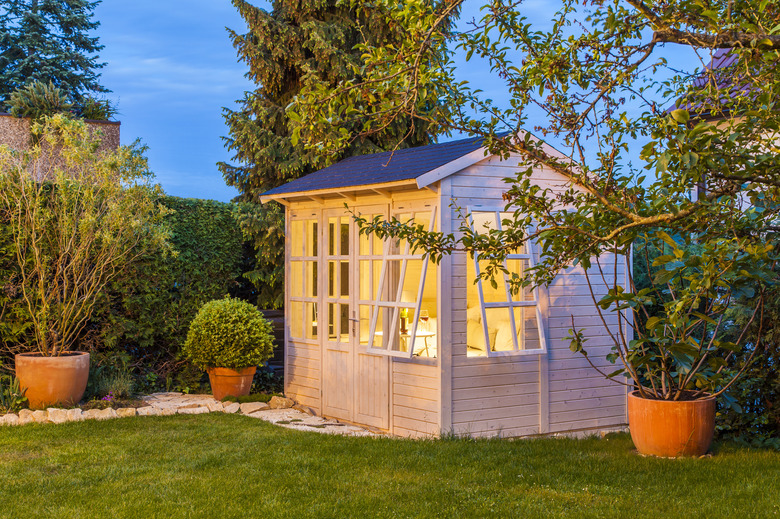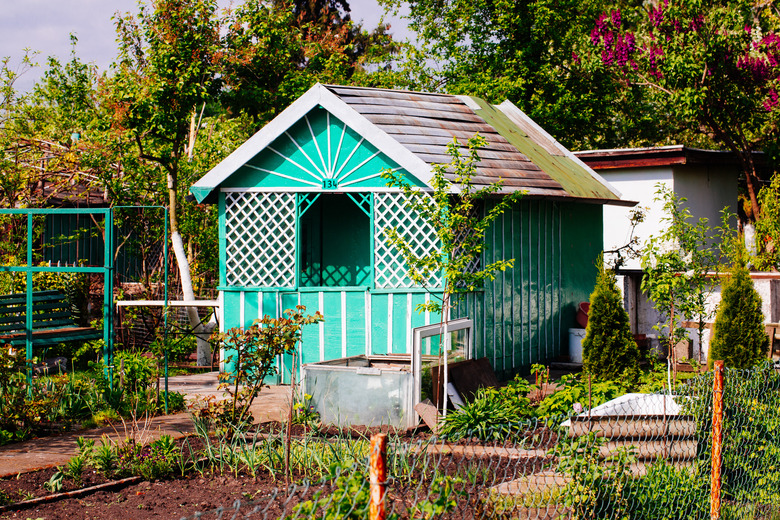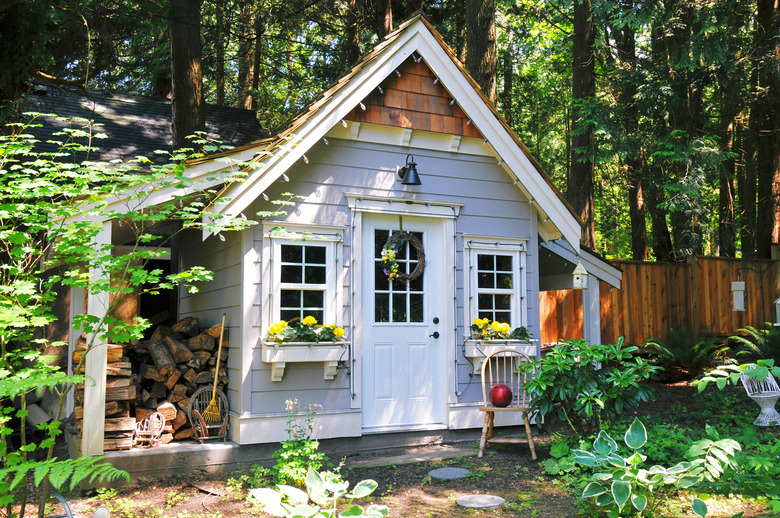Foundation Options For Building A Storage Shed
We may receive a commission on purchases made from links.
If you're building a shed, even a small storage shed, you'll want to give some thought to the shed foundation. Don't repeat the mistake more than one homeowner has made by building a shed on an inadequate foundation or without one at all only to watch the shed deteriorate from water damage or soil erosion in just a few years. Various foundation possibilities exist, from a concrete slab or concrete pavers to a post-and-pier foundation, and the best type depends on how big a shed you're building, its intended use, the topography of the land and drainage and, as with any DIY project, how much you want to spend.
A shed foundation can sit on-grade (or right at ground level), or it can consist of concrete footers sunk into the ground and supporting heavy beams. In Northern climates, foundations with sunken footers are usually frostproof, which means that the footers are sunk below the frost line, preventing the footers from heaving upward when the ground freezes. Frostproof foundations are permanent as opposed to skids or other types of on-grade foundations that can be easily removed, and as such, they must adhere to building codes and often require a building permit.
Building authorities often allow an unpermitted shed on a property as long as it is detached from the main building and has a floor area below a certain limit (often 100 to 120 square feet). Such an unpermitted storage shed is handy for keeping gardening tools out of the rain, and you can also use it for a workshop, but it still needs a foundation, or it won't provide safe storage and won't last long. It's good to know that many shed foundation options are easy to DIY and don't cost much, so there's no reason to simply plunk your new prefabricated shed on the bare ground and watch it gradually sink.
The Two Best On-Grade Options
The Two Best On-Grade Options
On-grade foundations are easier to build than frostproof ones and are generally suitable for sheds with a floor area of less than about 150 square feet. Less digging is involved in the construction, although you still do have to level the ground, and for very small sheds, you can often get by with inexpensive and easy-to-handle materials, such as gravel or pavers. Most on-grade foundations are temporary except for one, and it's probably the best shed foundation of them all: a concrete slab.
Pouring a concrete slab foundation, especially a large one, is not a DIY project, and the cost for a 160-square-foot slab is likely to be in a range from $1,200 to $1,800 depending on where you live. That includes materials and labor but doesn't include the cost of excavating, which can easily add $1,000 or more if you use heavy machinery. If you build the pad thick enough to support vehicles — typically 6 inches instead of the standard 4 inches — costs can go up by 10 percent or more. Also note that your city's building department may consider a shed to be a permanent structure if it has a concrete foundation, potentially making it subject to stricter building code or zoning rules.
A post-and-pier foundation is a less costly on-grade option, and it's built with concrete piers and pressure-treated beams. The piers come with metal brackets that can hold a 4x4 or 4x6 beam, and you set each one flat and level with the others by using string and a line level or, even easier, a laser level. Setting joists on top of the beams perpendicular to them and laying on a 3/4-inch plywood shed floor creates a floor 12 inches or more above grade, which is more than high enough to keep the floor dry, although you'll need steps or a ramp to get into the shed. Although this is less costly than a concrete foundation slab, especially if you do the work yourself, it isn't free and will cost from $400 to $500 for a 160-square-foot shed.
Easy Options for an On-Grade Shed Foundation
Easy Options for an On-Grade Shed Foundation
When you're building a shed, one of the first steps is to look for a level patch of ground or at least one that requires as little excavation as possible. If the ground is level, you can avoid excavating altogether by laying a frame constructed with 6x6 or 8x8 timbers directly on compacted gravel and filling in the space with gravel, cement blocks or pavers. The timbers must be level with themselves and with each other, so some digging is involved, and they should be laid on a 2-inch or thicker gravel base to prevent sinking. The usual way to secure the timbers is to connect them to each other at the corners with half-lap joints, drill holes through the joints and drive 2-foot lengths of 1/2-inch rebar through holes into the ground.
Having constructed the frame, you then remove all the sod from the ground within the frame, tamp down the earth with plate compacter and lay landscape fabric to block weeds. You can then backfill all the way with angular gravel or pea gravel, or you can backfill part way with gravel, cover the gravel with a 2-inch layer of sand and lay pavers or cement blocks, gauging the amount of gravel and sand to bring the pavers to the same height as the timber frame. This type of foundation, which costs about as much as one made with concrete piers and beams, can be made quickly, but it is prone to sinking if the soil should shift, and it may require a drainage system.
An even easier option is to build a skid foundation, which is little more than two or three timbers laid side by side on a bed of compacted gravel to prevent them from sinking. It's called a skid foundation because it allows you to skid the shed off when you want to move it. One more easy foundation can be made using permeable paver grids, which are modular plastic or steel units that sit on the ground and hold gravel. These relatively recent additions to the paver market don't require a frame and may be the easiest foundation option of all, costing just shy of $500 for a 160-square-foot structure, gravel not included.
Using a Prefab Foundation
Using a Prefab Foundation
Some prefabricated garden sheds come with their own floors, and because these sheds are typically very lightweight and easy to assemble, you usually don't need to supplement it with any other type of foundation, although this may be recommended in some situations. It's important that the ground on which you set the foundation be level; you may want to spread several inches of gravel and compact it before erecting the shed.
It's also important to choose a well-drained site because prefab foundations aren't very high and won't do much to keep runoff out of the shed. If water tends to collect on or flow through your chosen spot, you can still use a prefab foundation, but you should set it on pavers, a bed of gravel or some other on-grade foundation to keep the shed well above the water line.
Prefab foundations are typically lightweight and easy to handle and assemble. Just follow the manufacturer's directions and be sure to finish tightening all the screws and bolts needed to hold it together before you erect the shed because they probably won't be accessible afterward. Prefab foundations can often be used with sheds other than the ones for which they are intended as long as the dimensions are the same.
Accounting for Sloping or Frosty Ground
Accounting for Sloping or Frosty Ground
Ground that slopes 6 inches or less along the length or width of the shed can usually be excavated to create a flat area for an on-grade foundation, but slopes greater than that call for posts and beams similar to those you use with pier blocks but more stable. You have to bury something in the ground, such as concrete footers, screw piles or the posts themselves, and since whatever you bury has to be deeper than the frost line to prevent heaving, the foundations are known as frostproof. In the Northern part of the United States, the frost line can be as deep as 80 inches, while in the Deep South, it may only be 4 or 5 inches.
A frostproof foundation is the best option for a large shed or one that has to support heavy weight or multiple stories, and it usually requires a building permit. It also calls for more building expertise than an on-grade foundation, and it usually costs more, especially in the North, where holes are deep enough to require heavy machinery to dig them.
- A concrete footer foundation is the most stable frostproof shed base you can provide. You dig holes that extend 6 inches or more below the frost line, fill them with 4 to 6 inches of gravel for drainage and then set plastic or cardboard concrete tubes that extend at least 6 inches above ground level. After plumbing each tube, you backfill the tube and the rest of the hole with concrete, and while the concrete is wet, you install a post holder in the top of the tube so it will be embedded into the concrete. The post holders will support 6x6 or 8x8 pressure-treated posts or beams. Posts can be cut as needed to create a level shed base.
- You can create another type of foundation that is almost as stable as one with buried concrete footers by simply burying 6x6 or 8x8 posts directly in the ground and backfilling with concrete. Again, you should dig the holes at least 6 inches below the frost line and pour in 4 to 6 inches of gravel for drainage. You then set the posts, level them and backfill the holes with concrete. When the concrete sets, cut the posts to the proper height using a line level or laser level to guide you. This method calls for longer posts, and since wood costs more than concrete or concrete tubes, it's a slightly more expensive way of doing the job. Also, buried wood posts will eventually rot, unlike concrete footings.
- One of the easier shed foundation options, especially for builders in central and southern climate zones where the frost line isn't too deep, is to use screw piles, which are metal posts with threads that you basically screw into the ground. If the ground is loose enough, you can often install these manually by wedging a long piece of 2x4 into the post cap on the top of the pile and using it to screw down the post like a corkscrew. If you have to go very deep in rocky, compacted soil, you can also drive the screws with a small excavator and a screw attachment.
All of these shed foundation options call for beams and joists, just like pier-block foundations, and leveling the beams accurately when you set them is crucial. Precise measurements and careful cuts are essential for obtaining a flat, stable shed base.


